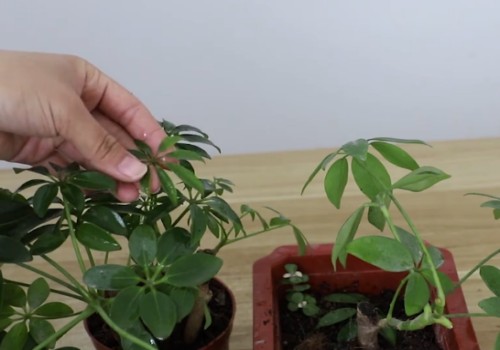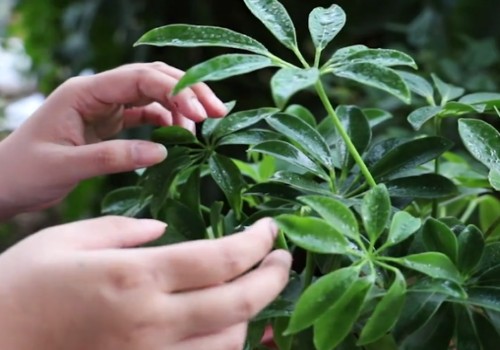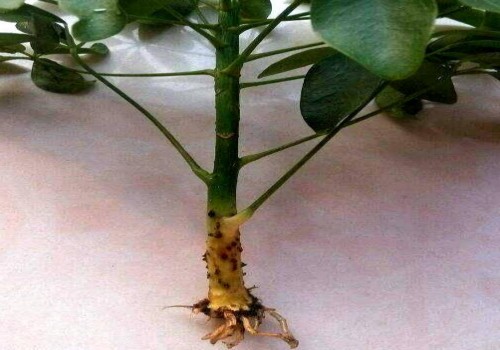Symptoms of duck feet before rotting roots
Duck foot wood, also known as goose palm wood, is named because its leaves are similar to duck paw or goose paw. It is a kind of evergreen shrub which is very suitable for viewing leaves and potted plants. Although the ornamental value of duck foot wood is very high, but in the actual maintenance process, there are still many people will encounter the loss of leaves, leaves black rot and so on. In fact, these phenomena are the performance of the rotten roots of duck foot wood.

However, duck foot wood usually shows some signals before rotting roots, and if we can grasp these signals, we can take timely measures to avoid rotting roots and cause more serious problems. So, what are the symptoms or signs before the duck feet rot? Today, the editor will share with you the symptoms before the rotting roots of duck feet.
For the duck foot wood with intact roots and normal growth, the new leaves at the top of the original plants are usually tender green and look lighter, while the old leaves are mostly dark green. However, if the plant is exposed to a lack of light for a long time, the young leaves may appear a little yellow. For this case, generally increase the light, the leaf color can return to normal.
However, if the color of the new leaves of duck foot wood is very yellow, and the leaves also appear uneven, even some curling. In this case, even if we adjust the light, we can't get the leaves back to normal. This is a symptom of stagnant water in the basin caused by overwatering.
This yellow is usually called water yellow, mainly because the roots are in a state of hypoxia after being soaked in water. Especially when there is a lack of nutrients, not only the new leaves will turn yellow, but also the leaves will become thin and curled.
The yellowing phenomenon of leaves caused by excessive watering is often shown on the new leaves, if we still do not stop watering at this time, the color of the whole plant will become dim and lose the true color of emerald green over a long time. Finally, until the root of the duck foot rotted, the leaves yellowed and fell off.
Therefore, in the maintenance process of duck foot wood, we must pay more attention to the change of leaf color. Once the phenomenon of water yellowing in new leaves is found, the water should be stopped in time, because this is mostly due to retting roots caused by excessive watering. In addition, measures such as ventilation and loosening soil should be strengthened in time to accelerate the evaporation of water in the basin. As long as the remedial measures we take are more timely, we can not only avoid the rotten roots of duck feet, but also restore the plant to its normal growth state before long.
Of course, in addition, lack of fertilizer may lead to yellowing of plant leaves. However, in the case of lack of fertilizer, the leaves of the whole tree will turn yellow, not just the new leaves in the water-yellow state. This is essentially different from the yellowing of leaves caused by excessive watering. Therefore, we can judge whether it is about to rot by observing the leaf color of duck foot wood, so as to make better remedial and preventive measures.
Time: 2019-05-27 Click:
- Prev

How to maintain the potted duck feet in the family
Many potted friends turn the duck foot wood into a wealth tree, so it can be seen that raising it at home as a potted plant is very helpful to improve the wealth of the family. And the duck foot wood likes the warm, moist, semi-shady growth environment, with the characteristics of heat and shade, so it is better to keep it at home. that
- Next

How to prevent the roots of duck feet from rotting
Duck foot wood is evergreen all the year round, with peculiar leaf shape, which has high ornamental value and greening and beautification effect. Although the duck foot wood is more resistant to drought and likes the moist growth environment, it is not resistant to waterlogging. If the water is overwatered, the accumulation of water in the basin will inhibit the respiration of the roots and cause rotting roots.
Related
- Fuxing push coffee new agricultural production and marketing class: lack of small-scale processing plants
- Jujube rice field leisure farm deep ploughing Yilan for five years to create a space for organic food and play
- Nongyu Farm-A trial of organic papaya for brave women with advanced technology
- Four points for attention in the prevention and control of diseases and insect pests of edible fungi
- How to add nutrient solution to Edible Fungi
- Is there any good way to control edible fungus mites?
- Open Inoculation Technology of Edible Fungi
- Is there any clever way to use fertilizer for edible fungus in winter?
- What agents are used to kill the pathogens of edible fungi in the mushroom shed?
- Rapid drying of Edible Fungi

